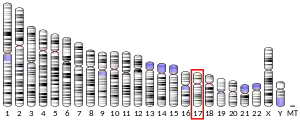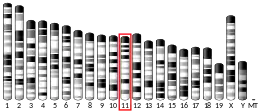TMC6
Transmembrane channel-like protein 6 is a protein that in humans is encoded by the TMC6 gene.[5][6] In vivo, TMC6 and its homolog TMC8, interact and form a complex with the zinc transporter 1 (SLC30A1) and localize mostly to the endoplasmic reticulum, but also to the nuclear membrane and Golgi apparatus.[7]
Inactivating mutations in TMC6 or TMC8 have been implicated as the genetic cause of the rare skin disorder epidermodysplasia verruciformis,[7] which is characterized by abnormal susceptibility to human papillomaviruses (HPVs) of the skin resulting in the growth of scaly macules and papules, particularly on the hands and feet.
References
- GRCh38: Ensembl release 89: ENSG00000141524 - Ensembl, May 2017
- GRCm38: Ensembl release 89: ENSMUSG00000025572 - Ensembl, May 2017
- "Human PubMed Reference:". National Center for Biotechnology Information, U.S. National Library of Medicine.
- "Mouse PubMed Reference:". National Center for Biotechnology Information, U.S. National Library of Medicine.
- Ramoz N, Rueda LA, Bouadjar B, Montoya LS, Orth G, Favre M (Nov 2002). "Mutations in two adjacent novel genes are associated with epidermodysplasia verruciformis". Nat Genet. 32 (4): 579–81. doi:10.1038/ng1044. PMID 12426567. S2CID 20013445.
- "Entrez Gene: TMC6 transmembrane channel-like 6".
- Lazarczyk, M; C Pons; JA Mendoza; P Cassonnet; Y Jacob; M Favre (2008-01-21). "Regulation of cellular zinc balance as a potential mechanism of EVER-mediated protection against pathogenesis by cutaneous oncogenic human papillomaviruses". The Journal of Experimental Medicine. 205 (1): 35–42. doi:10.1084/jem.20071311. PMC 2234378. PMID 18158319.
Further reading
- Olsen JV, Blagoev B, Gnad F, et al. (2006). "Global, in vivo, and site-specific phosphorylation dynamics in signaling networks". Cell. 127 (3): 635–48. doi:10.1016/j.cell.2006.09.026. PMID 17081983. S2CID 7827573.
- Zuo YG, Ma D, Zhang Y, et al. (2007). "Identification of a novel mutation and a genetic polymorphism of EVER1 gene in two families with epidermodysplasia verruciformis". J. Dermatol. Sci. 44 (3): 153–9. doi:10.1016/j.jdermsci.2006.08.013. PMID 17008061.
- Donfack J, Buchinsky FJ, Derkay CS, et al. (2006). "Four mutations in Epidermodysplasia verruciformis 1 (EVER1) gene are not contributors to susceptibility in RRP". Int. J. Pediatr. Otorhinolaryngol. 70 (7): 1235–40. doi:10.1016/j.ijporl.2006.01.001. PMID 16487602.
- Gerhard DS, Wagner L, Feingold EA, et al. (2004). "The status, quality, and expansion of the NIH full-length cDNA project: the Mammalian Gene Collection (MGC)". Genome Res. 14 (10B): 2121–7. doi:10.1101/gr.2596504. PMC 528928. PMID 15489334.
- Tate G, Suzuki T, Kishimoto K, Mitsuya T (2004). "Novel mutations of EVER1/TMC6 gene in a Japanese patient with epidermodysplasia verruciformis". J. Hum. Genet. 49 (4): 223–5. doi:10.1007/s10038-004-0135-6. PMID 15042430.
- Ota T, Suzuki Y, Nishikawa T, et al. (2004). "Complete sequencing and characterization of 21,243 full-length human cDNAs". Nat. Genet. 36 (1): 40–5. doi:10.1038/ng1285. PMID 14702039.
- Kurima K, Yang Y, Sorber K, Griffith AJ (2004). "Characterization of the transmembrane channel-like (TMC) gene family: functional clues from hearing loss and epidermodysplasia verruciformis". Genomics. 82 (3): 300–8. doi:10.1016/S0888-7543(03)00154-X. PMID 12906855.
- Keresztes G, Mutai H, Heller S (2003). "TMC and EVER genes belong to a larger novel family, the TMC gene family encoding transmembrane proteins". BMC Genomics. 4 (1): 24. doi:10.1186/1471-2164-4-24. PMC 165604. PMID 12812529.
- Strausberg RL, Feingold EA, Grouse LH, et al. (2003). "Generation and initial analysis of more than 15,000 full-length human and mouse cDNA sequences". Proc. Natl. Acad. Sci. U.S.A. 99 (26): 16899–903. doi:10.1073/pnas.242603899. PMC 139241. PMID 12477932.
- Ramoz N, Taïeb A, Rueda LA, et al. (2000). "Evidence for a nonallelic heterogeneity of epidermodysplasia verruciformis with two susceptibility loci mapped to chromosome regions 2p21-p24 and 17q25". J. Invest. Dermatol. 114 (6): 1148–53. doi:10.1046/j.1523-1747.2000.00996.x. PMID 10844558.
- Ramoz N, Rueda LA, Bouadjar B, et al. (1999). "A susceptibility locus for epidermodysplasia verruciformis, an abnormal predisposition to infection with the oncogenic human papillomavirus type 5, maps to chromosome 17qter in a region containing a psoriasis locus". J. Invest. Dermatol. 112 (3): 259–63. doi:10.1046/j.1523-1747.1999.00536.x. PMID 10084299.
This article is issued from Wikipedia. The text is licensed under Creative Commons - Attribution - Sharealike. Additional terms may apply for the media files.



